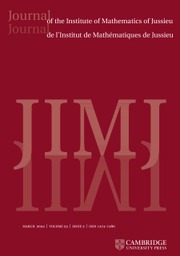No CrossRef data available.
Article contents
ON ODA’S PROBLEM AND SPECIAL LOCI
Published online by Cambridge University Press: 12 November 2024
Abstract
Oda’s problem, which deals with the fixed field of the universal monodromy representation of moduli spaces of curves and its independence with respect to the topological data, is a central question of anabelian arithmetic geometry. This paper emphasizes the stack nature of this problem by establishing the independence of monodromy fields with respect to finer special loci data of curves with symmetries, which we show provides a new proof of Oda’s prediction.
MSC classification
- Type
- Research Article
- Information
- Journal of the Institute of Mathematics of Jussieu , Volume 24 , Issue 2 , March 2025 , pp. 503 - 539
- Copyright
- © The Author(s), 2024. Published by Cambridge University Press
Footnotes
Supported by JSPS KAKENHI Grant Number 22F22015 (S. Philip) and by the Research Institute for Mathematical Sciences, Kyoto University. This work is part of the “Arithmetic and Homotopic Galois Theory” project, supported by the CNRS France-Japan AHGT International Research Network between the RIMS Kyoto University, the LPP of Lille University, and the DMA of ENS PSL.



